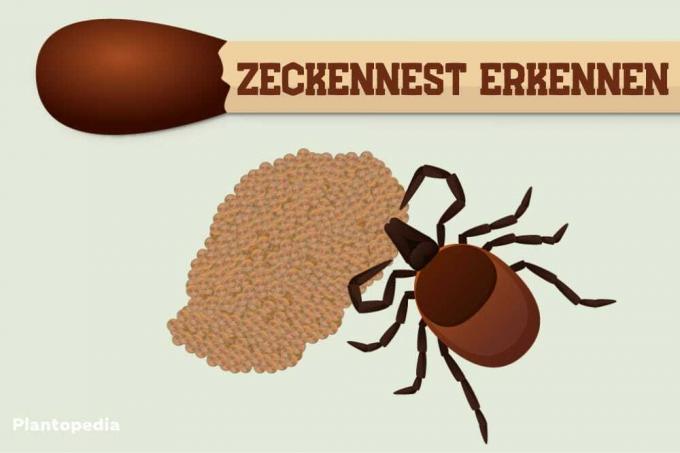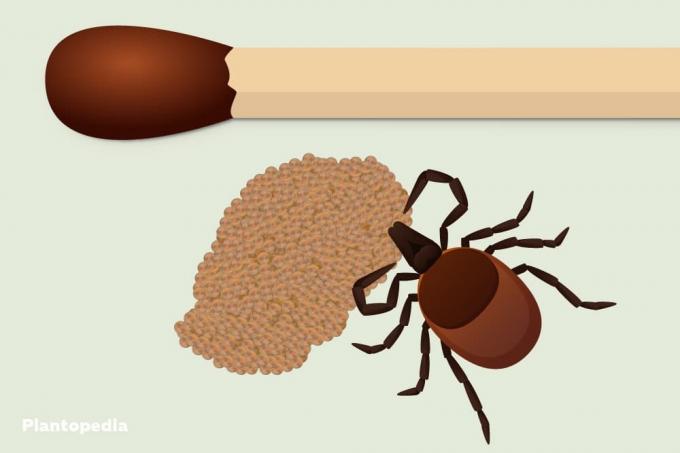
table of contents
- Tick nest under leaf litter
- Larvae hatch in the nest
- frequently asked Questions
The small arachnid, the tick (Ixodida), has its main season during the summer months. The small bloodsucker transmits diseases such as Lyme disease and TBE. It can also be found in gardens and so is its nest.
In a nutshell
- Special features: to find tick nest in dark, damp place and
- Nest consisting of several thousand eggs
- From this development of larvae
- Can transmit diseases even in the larval stage
Tick nest under leaf litter
A female tick needs a copious meal of blood to reproduce. This is needed to produce eggs. After mating, the female then lays her eggs in a dark place on the ground. Eggs are laid within 16 to 20 days. Then she dies. Such a clutch can consist of 3,000 to 20,000 eggs. The number depends on the type of tick. In this country, the common wood tick (Ixodes ricinus) occurs most frequently. Typical characteristics for a tick nest are:

- thousands of brownish to slightly black, small eggs
- covered with a protective layer
- prevents the eggs from drying out
- darker, more humid places preferred
- mostly under leaf litter
- The required high humidity is available here
Note: Ticks spend 99 percent of their lives looking for a suitable host.

Larvae hatch in the nest
There are three stages of development necessary for the adult tick. The first stage begins with the hatching of the larvae from the eggs after 16 to 30 days. These are:
- 0.5 cm long
- reddish brown to slightly black
- have six legs

Already Larvae can transmit diseases like Lyme disease. They feed on the blood of small mammals such as:
- hamster
- Mice and
- Rats
When they are fully sucked, they drop to the ground, shed their skin and develop into a sexless nymph with eight legs and a size of 1.5 mm. They live freely on the ground, in the undergrowth, meadows and bushes and suck the blood of larger mammals such as dogs, cats, deer or foxes. This then began the development of the adult 3.5 to 4.5 mm bloodsucker with eight legs.

Note: It can quickly take two to three or even several years to develop from larva to adult. It always depends on finding a suitable host for a blood meal. But no problem for ticks, they can starve for a long time.
frequently asked Questions
How can you protect yourself from ticks?
It is best to avoid tall grass and undergrowth in summer. On an excursion into nature, closed, long clothing, i.e. long trousers and a long-sleeved shirt, should always be worn. It also makes sense to tuck your trouser legs into your socks. If necessary, the skin and clothing can also be sprayed with an anti-tick spray. The effect lasts for a few hours. Gloves should always be worn when gardening.
Even regular mowing of the lawn can protect against tick infestation, because short ones race do not you like. Overgrown shrubs and bushes should also be cut and wild growth should be avoided. This way, more sun gets into the garden. Furthermore, unnecessary accumulations of leaves and scrub must be avoided. Should these provide shelter for small animals, but then please not directly next to the seating area. Barriers made of gravel and wood chips between a bed and a lawn are also useful.
The scent of citrus fruits can be used here. The little bloodsuckers don't like him. Either two oranges, limes, grapefruit or lemons are simply boiled in half a liter of water for an hour. Then the liquid must be strained and allowed to cool. The finished brew can then be sprayed with a spray bottle in nests and other places where ticks reside, as well as on the skin and fur of dogs and cats.



